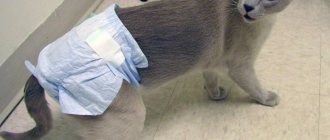Toxoplasmosis in cats is a dangerous disease that can affect not only beloved pets, but also members of the household. Ignoring the symptoms of the disease can lead to irreversible consequences. The causative agent of the disease penetrates every cell of the body, which leads to disruption of the functioning of vital organs. The animal experiences convulsions and paralysis. In advanced cases, a cat with toxoplasmosis dies. To avoid such an unfavorable picture, it is worthwhile to understand in more detail the issues related to this disease.
What is toxoplasmosis
This is an infectious disease, its appearance is provoked by the protozoan organism Toxoplasma gondii.
This infection is very often diagnosed in cats; it is considered one of the most common diseases. The pathogen can be detected on almost any surface or in water.
This widespread distribution is explained by the fact that Toxoplasma is resistant to adverse environmental influences and the complexity of development. Microorganisms are able to remain viable for one and a half years, even when exposed to harsh environmental conditions. Almost a third of the world's population is a carrier of this parasite. It can also be found in the bodies of every second mammal.
Development cycle of toxoplasmosis
The development of the protozoan consists of several cycles, for which it requires a change of hosts. Outside the host, the parasite exists in the form of a cyst. When it enters the body of a temporary host, which is animals, birds or humans, Toxoplasma begins the phase of active division. Parasites quickly spread throughout all tissues of the body and form cysts. Next, the cat, having eaten an infected rodent or bird, becomes infected and becomes the permanent host of the harmful microorganism. In a cat's body, the parasite reproduces through sexual intercourse.
The spread of the protozoan throughout the tissues and systems of the host body causes disruption of their normal functioning. Severe intoxication is observed, aggravating the destructive processes.
Cysts formed in the host’s body enter the external environment and then into a new intermediate host. The cycle begins again.
Routes of infection
Veterinarians have studied quite well the ways in which pathogenic protozoa enter the cat’s body. Most often, infection occurs nutritionally, that is, through the mouth. There is a good chance that a sick cat ate an infected mouse or simply licked a soil-stained paw. Infection can also occur by eating small birds. After all, as mentioned earlier, rodents and birds act as intermediate hosts of toxoplasma.
Infection does not always occur through nutrition; sometimes the cause of toxoplasmosis is simple contact with a carrier. Cats that don't have access to the outdoors can also get sick. There is a possibility of infection entering the host's body through water or contaminated food. Very often, unprocessed meat becomes the source of toxoplasmosis. Therefore, if your pet’s diet contains raw meat, make sure that it is previously frozen. The death of the parasite occurs at temperatures below -25 degrees.
Owners of kittens or older animals need to be especially vigilant. Animals under one year or older than seven years are most susceptible to infection with toxoplasmosis. The age differentiation of risk groups is determined by the characteristics of immunity. In young pets, it is not yet fully formed; in older pets, the functioning of the immune system is declining. Therefore, these categories of cats are the most vulnerable to infectious diseases, including toxoplasmosis. In addition, weak and sick cats are at risk.
When Toxoplasma enters the body of a permanent host, it invades its cells and is divided into two groups.
- The first group invades the small intestine and begins active reproduction there, during which oocysts are formed. They represent a temporary form of existence of a microorganism. Oocysts are excreted from the animal's body along with fecal matter. Then they ripen in a tray for 24 hours. Fully formed cysts are dangerous to humans. Therefore, it is very important to thoroughly clean the cat litter box on time. The release of cysts into the external environment lasts approximately three weeks.
- Representatives of the second group attack tissues and cells of the body, which leads to their destruction. At this stage, the cat’s body gives signals about the presence of the disease. The cat develops symptoms.
The effect of essential oils on a cat’s body when aromatizing rooms
If we are talking about spraying essential oils in the air, then there is no point in making a list of safe or toxic essential oils, we can only talk about general safety rules. There are few such rules. A cat can be in a room where essential oils are diffused without any harm to itself if:
- The room is well ventilated
- The concentration of essential oils in the air is low (it doesn’t hurt your eyes when entering the room)
- The cat can leave the room at any time
- Do not diffuse essential oils in the room where your cat lives more than once every 48 hours. This is the time during which the cat's body can cope with the toxic substances of essential oils without harming itself.
The danger of toxoplasmosis for cats and humans
As mentioned earlier, toxoplasmosis in cats can cause serious problems in the functioning of vital organs. If the disease is not treated, it can lead to the death of your pet. The danger of this disease also lies in the fact that there is a possibility of human infection.
Human infection can occur even if the cat shows no symptoms. The infection enters the body through contact with a sick cat or litter box. When she licks herself, the parasite can remain on her fur. Therefore, there is no need to kiss the animal. After contact with the cat, you must wash your hands thoroughly.
Healthy adults rarely get toxoplasmosis. Pregnant women are at particular risk. Protozoa enter the fetus through the placenta, causing irreversible pathologies, miscarriage or frozen pregnancy.
It is worth considering that a woman may have developed immunity to this disease if she has already been sick before. The analysis will allow us to find out this. If antibodies to toxoplasma are detected in the body, then the risk of contracting the disease again is zero.
If antibodies are not found, a pregnant woman should be careful. It is necessary to limit contact with the cat and carefully handle all vegetables, fruits and meat.
Human infection can occur through organ transplantation and blood transfusion. You can also catch the infection through the bite of blood-sucking insects. In addition, harmful microorganisms can enter the human body through cuts or wounds.
The disease often occurs without symptoms if the person’s immune system is strong enough. Sometimes it can manifest itself in the form of a slight increase in temperature, the appearance of weakness and nervousness. There is an increase in lymph nodes, disruptions in the sexual sphere, abdominal pain and vision problems. Symptoms of toxoplasmosis can be confused with those of the flu.
How to stop a cat from eating house flowers
Indoor plants can be sprayed with various compounds, the taste of which the cat will not like. There are special sprays that can be bought at a pet store.
You can also prepare a repellent yourself. To do this, add aloe juice, red pepper, and sour apple juice to a spray bottle with water. Plants treated with this composition will become unpalatable to the cat.
However, before spraying, you need to make sure that the substance will not harm the flower. To do this, the composition is tested on 1-2 leaves, and only then the whole flower is treated.
Symptoms of the disease and its diagnosis
The disease in cats begins to manifest itself only three weeks after Toxoplasma enters the body. A slight runny nose and watery eyes appear. One-time vomiting or loose stools may occur. It is not surprising that the first manifestations of toxoplasmosis are often confused with the common cold. After a couple of days, these symptoms disappear. This does not mean that the disease has receded. It simply went from the acute stage to the chronic stage.
If the animal’s immunity is weakened, then the acute form of the disease is delayed. In this case, the pet exhibits the following signs:
- increased body temperature;
- enlarged lymph nodes;
- seizures or paralysis;
- deterioration of vision and hearing;
- general weakness, reluctance to play;
- problems with stool: diarrhea or constipation;
- mucous membranes acquire a yellowish tint;
- miscarriages;
- death of born kittens.
Only a veterinarian can make an accurate diagnosis. Therefore, if the above symptoms appear, you must immediately show the cat to a specialist.
To determine toxoplasmosis, a number of diagnostic procedures will be required. This includes:
- conducting a bioassay on experimental mice;
- serological blood test to detect the presence of toxoplasmosis in cats;
- the most common method is cytological examination and polymer chain reaction;
- ultrasonography;
- X-ray.
None of these research methods gives an accurate result. Therefore, it is advisable to do several tests and manipulations at once. Checking stool for the presence of cysts is not at all informative. They appear in feces only in the first three weeks after infection, and at this time symptoms do not yet appear. When the disease begins to manifest itself, the release of cysts has already stopped. Therefore, it is pointless to waste time and money on stool analysis.
Treatment of toxoplasmosis
It is necessary to begin treatment for your beloved pet only as prescribed by a doctor. If it is not possible to immediately show the cat to a veterinarian, then before going to a specialist, it is recommended to limit the animal’s contact with household members. It is not permissible for children or pregnant women to approach the cat.
The primary goal in the treatment of toxoplasmosis is to inhibit the process of parasite reproduction in the host's body. To achieve this task, Rovamycin, Biseptol or another medical drug is prescribed. The duration of the medication depends on how long the cat has been suffering from this disease.
If the cat is pregnant, then prescribing drugs of the sulfonamide group is unacceptable. She is prescribed Spiramycin.
In addition, the infected cat will be prescribed medications to eliminate symptoms and negative consequences. Dehydration is treated with glucose drips, and bone marrow function is supported by taking folic acid. Sometimes it is advisable to use immunomodulating drugs. These include "Fosprinil" or "Gamavit". Injections of vitamins will not be superfluous; most often, veterinarians prescribe vitamin B or ascorbic acid.
Kittens, like adults, are susceptible to this disease. The course of the disease is approximately the same as in cats. However, the acute form of the disease is more common in kittens. In this case, characteristic symptoms are present in the form of convulsions, loss of coordination, malaise and yellowness of the mucous membranes.
Kittens are prescribed the same medications as adult animals. In this case, the doctor adjusts the dosage according to age.
Self-treatment of kittens according to a regimen that was developed by a veterinarian for an adult cat is unacceptable. An unformed body can react unpredictably to improper treatment.
There is still no consensus on the advisability of using traditional methods of treating this disease. To combat the disease, traditional medicine suggests using decoctions of hoofed grass, buckthorn, kupena and other medicinal herbs. A teaspoon of dry raw materials must be brewed with a glass of boiling water and allowed to brew. It is recommended to give the decoction to a cat suffering from toxoplasmosis, a teaspoon twice a day.
If you decide to resort to this method of treatment, you must first consult a veterinarian.
How to scare cats away - popular industrial products
- NM JFC Pet Block Cat Repellent Spray;
- Beafar STOP IT CAT;
- Mr. Fresh Anti-scratch protection;
- Spray repeller for cats Faithful friend “4 in 1”;
- Stop Problem.
NM JFC Pet Block Cat Repellent Spray
The scent repellent product for cats has a special, concentrated, long-lasting formula that helps reduce litter box training time and prevents unwanted behavior in your pet.
Areas of walls, furniture and other interior items treated with this product are reliably protected from cat claws. The spray contains a natural repellent. The product is completely safe for people and pets.
Price: bottle 237 ml. – 450 rub. More details about the product
Beafar STOP IT CAT
A reliable repellent spray weans cats from places where they are undesirable. The product contains: methylnonyl ketone - a substance with an odor that resembles acetone. In nature, this substance is found in large quantities in the fragrant rue plant.
To achieve maximum effect, it is necessary to treat the places chosen by cats for their toilet every 24 hours until the animal stops shitting past the tray.
Price: bottle 100 ml. – 580 rub. More details about the product
Mr. Fresh Anti-scratch
An inexpensive, domestically produced spray protects walls and furniture from scratching. The drug contains: isopropyl alcohol, wormwood bitterness and fragrance. The product is absolutely safe for animals and humans.
Price: 200 ml. – 156 rub. More details about the product
Spray repeller for cats Faithful friend “4 in 1”
The product discourages cats from scratching and marking places that are not intended for this. Treatment is carried out according to the instructions until the animal completely loses interest in the treated surfaces. Neutralizes unpleasant odors.
Price: 200 ml. – 135 rub. More details about the product










